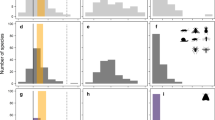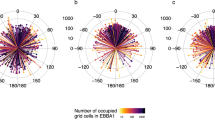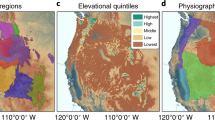Abstract
There is an urgent need to develop effective vulnerability assessments for evaluating the conservation status of species in a changing climate1. Several new assessment approaches have been proposed for evaluating the vulnerability of species to climate change2,3,4,5 based on the expectation that established assessments such as the IUCN Red List6 need revising or superseding in light of the threat that climate change brings. However, although previous studies have identified ecological and life history attributes that characterize declining species or those listed as threatened7,8,9, no study so far has undertaken a quantitative analysis of the attributes that cause species to be at high risk of extinction specifically due to climate change. We developed a simulation approach based on generic life history types to show here that extinction risk due to climate change can be predicted using a mixture of spatial and demographic variables that can be measured in the present day without the need for complex forecasting models. Most of the variables we found to be important for predicting extinction risk, including occupied area and population size, are already used in species conservation assessments, indicating that present systems may be better able to identify species vulnerable to climate change than previously thought. Therefore, although climate change brings many new conservation challenges, we find that it may not be fundamentally different from other threats in terms of assessing extinction risks.
This is a preview of subscription content, access via your institution
Access options
Subscribe to this journal
Receive 12 print issues and online access
$209.00 per year
only $17.42 per issue
Buy this article
- Purchase on Springer Link
- Instant access to full article PDF
Prices may be subject to local taxes which are calculated during checkout


Similar content being viewed by others
References
Dawson, T. P., Jackson, S. T., House, J. I., Prentice, I. C. & Mace, G. M. Beyond predictions: Biodiversity conservation in a changing climate. Science 332, 53–58 (2011).
Foden, W. B. et al. Identifying the world’s most climate change vulnerable species: a systematic trait-based assessment of all birds, amphibians and corals. PLoS ONE 8, e65427 (2013).
Thomas, C. D. et al. A framework for assessing threats and benefits to species responding to climate change. Methods Ecol. Evol. 2, 125–142 (2011).
Young, B. E. et al. Wildlife Conservation in a Changing Climate 129–152 (Univ. Chicago Press, (2012).
Gillson, L., Dawson, T. P., Jack, S. & McGeoch, M. A. Accommodating climate change contingencies in conservation strategy. Trends Ecol. Evol. 28, 135–142 (2013).
Mace, G. M. et al. Quantification of extinction risk: IUCN’s system for classifying threatened species. Conserv. Biol. 22, 1424–1442 (2008).
Collen, B. et al. Predicting how populations decline to extinction. Phil. Trans. R. Soc. B 366, 2577–2586 (2011).
Purvis, A., Gittleman, J. L., Cowlishaw, G. & Mace, G. M. Predicting extinction risk in declining species. Proc. R. Soc. Lond. B 267, 1947–1952 (2000).
Cardillo, M. et al. Multiple causes of high extinction risk in large mammal species. Science 309, 1239–1241 (2005).
Thomas, C. D. et al. Extinction risk from climate change. Nature 427, 147–148 (2004).
Thuiller, W., Lavorel, S., Araújo, M. B., Sykes, M. T. & Prentice, I. C. Climate change threats to plant diversity in Europe. Proc. Natl Acad. Sci. 102, 8245–8250 (2005).
Akçakaya, H. R., Butchart, S. H. M., Mace, G. M., Stuart, S. N. & Hilton-Taylor, C. Use and misuse of the IUCN Red List Criteria in projecting climate change impacts on biodiversity. Glob. Change Biol. 12, 2037–2043 (2006).
Fordham, D. A. et al. Plant extinction risk under climate change: are forecast range shifts alone a good indicator of species vulnerability to global warming?. Glob. Change Biol. 18, 1357–1371 (2012).
Fordham, D. A., Akçakaya, H. R., Araujo, M. B., Keith, D. A. & Brook, B. W. Tools for integrating range change, extinction risk and climate change information into conservation management. Ecography 36, 956–964 (2013).
Keith, D. A. et al. Predicting extinction risks under climate change: coupling stochastic population models with dynamic bioclimatic habitat models. Biol. Lett. 4, 560–563 (2008).
Buckley, L. B. et al. Can mechanism inform species’ distribution models?. Ecol. Lett. 13, 1041–1054 (2010).
Pereira, H. M. et al. Scenarios for global biodiversity in the 21st century. Science 330, 1496–1501 (2010).
Schurr, F. M. et al. How to understand species’ niches and range dynamics: a demographic research agenda for biogeography. J. Biogeogr. 39, 2146–2162 (2012).
Buckley, L. B. Linking traits to energetics and population dynamics to predict lizard ranges in changing environments. Am. Nat. 171, E1–E19 (2008).
Dullinger, S. et al. Extinction debt of high-mountain plants under twenty-first-century climate change. Nature Clim. Change 2, 619–622 (2012).
Wigley, T. M. L., Richels, R. & Edmonds, J. A. Economic and environmental choices in the stabilization of atmospheric CO2 concentrations. Nature 379, 240–243 (1996).
Wigley, T. M. L. et al. Uncertainties in climate stabilization. Climatic Change 97, 85–121 (2009).
Warren, R. et al. Quantifying the benefit of early climate change mitigation in avoiding biodiversity loss. Nature Clim. Change 3, 678–682 (2013).
Mawdsley, J. R., O’Malley, R. & Ojima, D. S. A review of climate-change adaptation strategies for wildlife management and biodiversity conservation. Conserv. Biol. 23, 1080–1089 (2009).
Rosenzweig, C. et al. Attributing physical and biological impacts to anthropogenic climate change. Nature 453, 353–357 (2008).
IUCN Standards and Petitions Subcommittee, Guidelines for Using The IUCN Red List Categories and Criteria (Version 10), 2013. www.iucnredlist.org/documents/RedListGuidelines.pdf
Pereira, H. M. et al. Essential biodiversity variables. Science 339, 277–278 (2013).
Fordham, D. A. et al. Adapted conservation measures are required to save the Iberian lynx in a changing climate. Nature Clim. Change 3, 899–903 (2013).
Hoffmann, A. A. & Sgrò, C. M. Climate change and evolutionary adaptation. Nature 470, 479–485 (2011).
Chevin, L.-M., Lande, R. & Mace, G. M. Adaptation, plasticity, and extinction in a changing environment: Towards a predictive theory. PLoS Biol 8, e1000357 (2010).
Elith, J., Leathwick, J. R. & Hastie, T. A working guide to boosted regression trees. J. Animal Ecol. 77, 802–813 (2008).
Acknowledgements
Financial support was provided by NASA (Biodiversity Program grant NNX09AK19G). The Australian Research Council supported D.A.F. (grants LP0989420, DP1096427and FS110200051). J. Palmer, S. Phillips, J. Ray, A. Sonneborn helped with analyses, G. Mace provided comments on a draft manuscript, and B. Young, NatureServe and its Natural Heritage member programmes provided data.
Author information
Authors and Affiliations
Contributions
R.G.P. and H.R.A. designed the study, analysed data and led writing the manuscript; R.G.P. ran ENMs; H.R.A. developed GLH models; J.C.S. selected variables for ENM and linked ENM and GLH models; J.C.S. and H.Y.R. collated demographic data and ran metapopulation simulations; K.T.S. led BRT and RF analyses; M.E.A.-L. sampled models from GLH and extracted simulation results; P.J.E. and N.H. developed ENM input data; D.A.F. led climate analyses; C.J.R. helped with species selection, variable selection and demographic data; J.M. collated species data; all authors discussed results and contributed to writing the manuscript.
Corresponding author
Ethics declarations
Competing interests
The authors declare no competing financial interests.
Supplementary information
Rights and permissions
About this article
Cite this article
Pearson, R., Stanton, J., Shoemaker, K. et al. Life history and spatial traits predict extinction risk due to climate change. Nature Clim Change 4, 217–221 (2014). https://doi.org/10.1038/nclimate2113
Received:
Accepted:
Published:
Issue Date:
DOI: https://doi.org/10.1038/nclimate2113
This article is cited by
-
Climate change and anthropogenic activities shrink the range and dispersal of an endangered primate in Sichuan Province, China
Environmental Science and Pollution Research (2023)
-
Species-specific traits affect bird species’ susceptibility to global change
The Science of Nature (2023)
-
Multiple dimensions of extreme weather events and their impacts on biodiversity
Climatic Change (2023)
-
Predicting the distribution of European Hop Hornbeam: application of MaxEnt algorithm and climatic suitability models
European Journal of Forest Research (2023)
-
Variation in intraspecific demography drives localised concordance but species-wide discordance in response to past climatic change
BMC Ecology and Evolution (2022)



